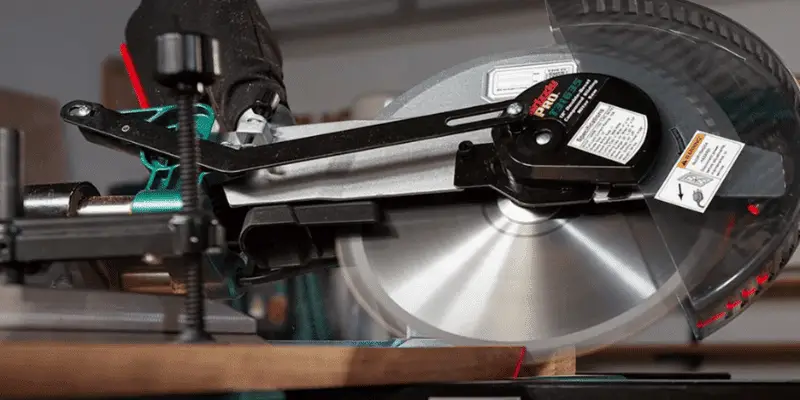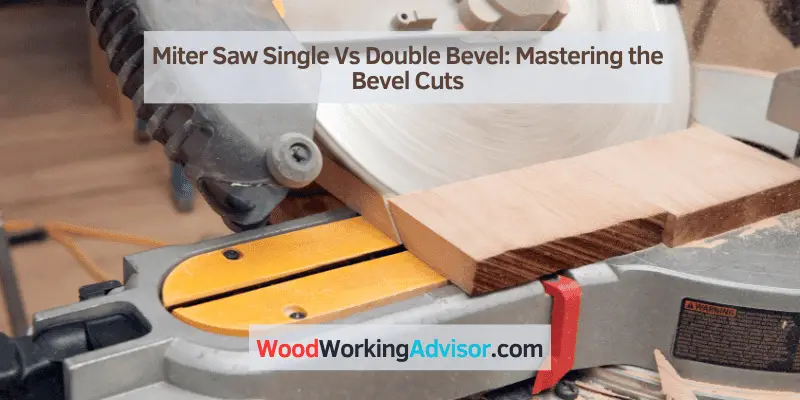A single-bevel miter saw can tilt in one direction, while a double-bevel miter saw can tilt in both directions. When choosing between the two, consider the type and complexity of your projects, as well as your budget and workspace constraints.
Miter saws come with single or double bevel options, and the choice between the two depends on your specific woodworking needs. Understanding the differences between them can help you make an informed decision when purchasing a miter saw for your workshop.
We will explore the key distinctions between single and double bevel miter saws, discuss the advantages and disadvantages of each option, and provide guidance on selecting the most suitable tool for your woodworking projects. Whether you are a DIY enthusiast or a professional woodworker, having the right miter saw can significantly enhance the accuracy and efficiency of your work. Let’s delve into the details and make the decision-making process easier for you.
Importance Of Bevel Cuts In Woodworking
Bevel cuts are a crucial aspect of woodworking, allowing for the creation of angled edges and joints in wood. From framing work to furniture making, bevel cuts are essential for creating pieces with professional precision and visual appeal. Whether you’re working on a simple DIY project or a complex construction task, understanding the difference between single and double bevel miter saws is essential to achieve the desired results.
Precision And Versatility
When it comes to precision and versatility, the choice between a single and double bevel miter saw is crucial. A single bevel miter saw can only tilt in one direction, requiring the workpiece to be flipped to make bevel cuts in both directions. On the other hand, a double bevel miter saw can tilt in both directions, allowing for seamless bevel cuts without the need to reposition the workpiece.
Common Applications
Bevel cuts are commonly used in a variety of woodworking applications, including:
- Creating angled edges for picture frames
- Constructing furniture with angled joints
- Installing crown molding and baseboards
- Building custom cabinetry with angled corners
Miter Saw: Single Bevel Features
When it comes to miter saws, the choice between single bevel and double bevel features is crucial. In this section, we will delve into the features of a miter saw with a single bevel and explore its definition, function, advantages, and limitations.

Definition And Function
A miter saw with a single bevel refers to a saw that can only tilt in one direction, usually to the left. This means that the blade can only be angled to make bevel cuts on one side of the material, requiring the material to be flipped to cut bevels on the opposite side. The primary function of a miter saw with a single bevel is to make accurate angled cuts on various types of materials such as wood, plastic, and metal.
Advantages And Limitations
The advantages of a miter saw with a single bevel lie in its simplicity and affordability. It is often more budget-friendly compared to double bevel saws, making it an ideal choice for beginners or DIY enthusiasts. Additionally, single bevel saws are typically lighter and more portable, allowing for easier transportation and maneuverability on job sites. However, the major limitation of a single bevel miter saw is the need to flip the material when making bevel cuts on both sides, which can be cumbersome and time-consuming for larger projects.
Miter Saw: Double Bevel Features
Miter saws are essential tools in woodworking and carpentry, giving professionals and DIY enthusiasts the ability to make accurate and precise angled cuts. When it comes to choosing a miter saw, understanding its features is crucial. In this article, we will explore the double bevel feature of miter saws, detailing its definition, purpose, as well as the pros and cons associated with this particular feature.
Definition And Purpose
The double bevel feature of a miter saw refers to the ability of the saw blade to tilt in both directions, allowing for angled cuts in either direction without needing to flip the workpiece. This feature is particularly useful for projects that require complex cuts, such as crown molding or other decorative trim work. Additionally, it simplifies the process of cutting bevels, saving time and effort for the user.
Pros And Cons
When considering the double bevel feature of a miter saw, it is important to weigh the pros and cons to determine if it aligns with your specific cutting needs.
Pros
- Enhanced efficiency: Double bevel miter saws allow for quicker and easier bevel adjustments, ultimately increasing workflow efficiency.
- Versatility: The ability to make bevel cuts in both directions offers greater versatility in tackling various projects and angles.
- Precision: With the double bevel feature, users can achieve precise and accurate cuts without the need to reposition the workpiece repeatedly.
Cons
- Cost: Double bevel miter saws are often priced higher than their single bevel counterparts, potentially posing a budgetary concern for some users.
- Complexity: The additional moving parts and mechanisms in double bevel miter saws may require a steeper learning curve for beginners or occasional users.
- Weight and size: Double bevel miter saws generally tend to be heavier and larger, which could be a consideration for portability and workspace limitations.
Comparison Of Single And Double Bevel Miter Saws
When it comes to choosing the right miter saw for your woodworking projects, the decision between a single bevel and a double bevel miter saw is crucial. Both types of miter saws have their unique features and benefits, and understanding the comparison of single and double bevel miter saws can help you make an informed choice based on your specific needs and preferences.
Accuracy And Efficiency
One of the primary considerations when comparing single and double bevel miter saws is the accuracy and efficiency they offer. Single bevel miter saws are designed to make angled cuts in only one direction. This means that for bevel cuts, you have to flip and reposition the workpiece, which may lead to potential inaccuracies and inefficiencies in the cutting process.
On the other hand, double bevel miter saws allow you to tilt the blade to both the left and right, eliminating the need to flip the workpiece. This results in greater accuracy and efficiency, especially when making bevel cuts on large or complex workpieces.
Best Practices For Mastering Bevel Cuts
Mastering bevel cuts on a miter saw, whether single or double bevel, requires a comprehensive understanding of the machine’s features and best practices. Regardless of the type of miter saw you choose, these best practices can help you achieve precise and professional bevel cuts:
- Ensure the workpiece is securely clamped or held in place to prevent any movement during the cutting process.
- Adjust the miter and bevel angles accurately according to your project specifications.
- Use sharp and appropriate blades for clean and precise cuts.
By adhering to these best practices, woodworkers can achieve consistent and high-quality bevel cuts, regardless of whether they are using a single or double bevel miter saw.
Frequently Asked Questions On Miter Saw Single Vs Double Bevel
What Is The Difference Between A Single And Double Bevel Miter Saw?
A single bevel miter saw tilts only to one side, while a double bevel miter saw can tilt to both left and right, allowing for easier bevel cuts without flipping the workpiece. Double bevel saws are more versatile but also more expensive.
Are Double Bevel Miter Saws Worth The Extra Cost?
Yes, the ability to tilt the blade in both directions eliminates the need to flip the workpiece, saving time and effort. This feature is especially valuable for complex woodworking projects and professionals who require precision and efficiency in their work.
Can A Single Bevel Miter Saw Perform The Same Cuts As A Double Bevel Saw?
While a single bevel can perform most common cuts, a double bevel’s ability to tilt in both directions offers greater ease and flexibility for bevel cuts, making it the preferred choice for those who frequently work with crown molding, picture frames, and other intricate designs.
How Does A Single Or Double Bevel Miter Saw Impact Safety?
Using a double bevel miter saw can reduce the need to manipulate the workpiece, leading to fewer opportunities for accidental cuts or errors. The ability to keep the workpiece stationary can contribute to a safer and more controlled working environment.
Conclusion
Overall, both miter saws have their advantages and disadvantages. The single bevel is more affordable and suitable for basic projects, while the double bevel offers convenience and efficiency for complex and professional tasks. Ultimately, the choice depends on your specific needs and budget.
Consider your requirements carefully before making a decision.



One thought on “Miter Saw Single Vs Double Bevel: Mastering the Bevel Cuts”